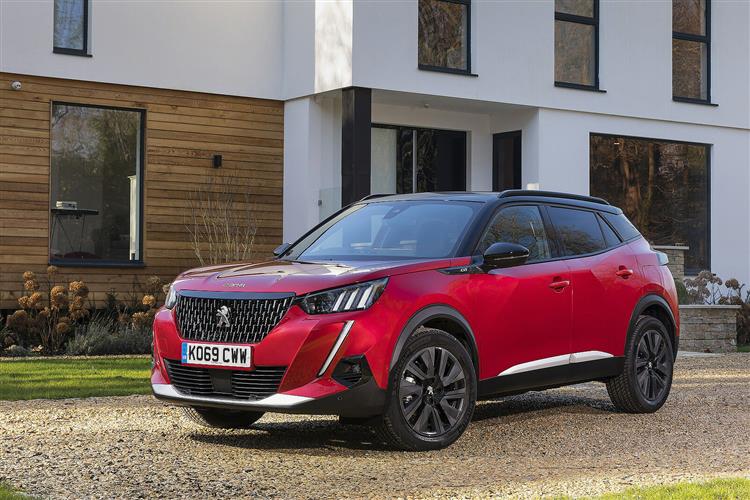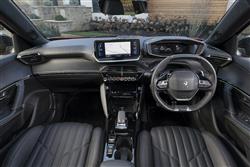AN EIGHT TO RATE (some text hidden) --NONE--
By Jonathan Crouch
Introductionword count: 120
Peugeot's second generation 2008 is a small SUV that offers an arguably more sophisticated take on the kind of little urban Crossover-style design popularised by cars like Nissan's Juke. Supermini-based, it offers all the advantages of that compact runabout you were thinking of, together with the kind of added space, style and light off road driveability you probably never expected to be able to enjoy on a small car budget. Launched in 2019, this MK2 design got a new platform, a fresh look and a completely redesigned interior, all of it targeting what the brand hoped would be a younger buyer. There was an all-electric e-2008 version too. Here, we look at the 2019-2023-era pre-facelift versions of this MK2 model.
Modelsword count: 14
5dr SUV (EV) [Active, Active Premium+, Allure, Allure Premium+, GT Line, GT, GT Premium]
Historyword count: 359
Back in 2019, the market's fastest growing segment was for cars like this - trendy, fashion-led little SUVs. And this one, at first glance, looked particularly appealing, Peugeot's second generation 2008. There's a chance you might already be familiar with this model line since it's been around since 2013. The original 2008 wasn't the cohesive piece of product design we got in MK2 form; instead it was more of a 'supermini-on-stilts', launched to test a market that had originated in modern form with the Nissan Juke three years earlier. The donor small supermini in question was then - and was with this MK2 model - Peugeot's 208 and that first 2008 sold well for its French maker - though more because of segment growth than product excellence. It gave the brand's designers though, some thinking space to consider what this class of customer really ought to have: something quite ground-breaking as it turned out when this second generation design was launched in late 2019 - the option of an all-electric powertrain. It wasn't obligatory to have it. This car's new CMP platform (shared with Stellantis class stablemates the Vauxhall Mokka and the DS 3 Crossback) was flexible enough to allow for all kinds of engines, including various non-electrified ones - an old school BlueHDi diesel: and the Puretech three cylinder petrol units that most 2008 customers chose from new. These conventional engines aren't very different from those used in the previous generation model - but carry-overs otherwise end right there, as you'll discover after sampling this second generation model's very different 3D i-Cockpit cabin. There's also a completely different level of safety provision and media connectivity to what was available before. More of what you want then - and less perhaps of what you don't, hence this MK2 model's slightly lower level of potential rough road competence. It's a long way from being the most affordable contender in this segment. But it lays a strong claim to being one of the most thoroughly engineered. The MK2 2008 sold in its original form until mid-2023, when it was significantly facelifted. It's the pre-facelift version though, that we look at here.
What You Getword count: 626
This second generation 2008 has what its predecessor lacked; a real sense of stylistic identity. Here, Designer Gilles Vidal evolved the shape of his second generation 208 supermini into that of a bold, robust and confident SUV. If you want this car, it'll be because you think it really stands out. And you'll be right. As with the 208, the front end is probably the most immediately arresting part of the design, with distinctive LED corner 'fangs' that flow up into the three-claw LED headlight signature. Look further up and you'll note the pared-back windscreen that makes the carved bonnet more horizontal. At the rear, the avant garde theme continues, with exact design and tautly-drawn shaping. The 3D tail lamps again feature that 3-claw signature and are linked by a black band running the width of the boot lid, emphasising this second generation 2008 model's extra width. From the side, an owner of the previous model might particularly notice the increase in size here. At 4.3m long, this second generation design is a significant 15cms lengthier than its predecessor, which makes this supermini-derived Peugeot longer than a Volkswagen Golf. There's also plenty in this muscular profile to catch the eye, with a high beltline, various repeating triangular lines and lots of intricate surfacing that must have made the panel pressing a real technical feat. At the wheel, it certainly has a very futuristic feel - and one of very high perceived quality, thanks to the two-tier fascia layout, with its smart carbon-trimmed concave inner section that curls around the edge of the cabin and on into the doors. Predictably, you sit a fraction higher than you would in a 208 (not always a given in the design of small SUVs these days) and as with the original 2008 model, this cabin champions Peugeot's unique so-called 'i-Cockpit' format, where you view the instrument binnacle over the upper rim of a tiny steering wheel rather than conventionally through the wheel spokes. Here though, the concept's been further developed with the addition of a 3D instrument binnacle display on plusher variants. This sees critical information like speed and navigational instructions projected in hologram form from the inner roof of the binnacle on to a piece of slanted Perspex in the foreground. Other secondary stuff features on a screen set further back and a button on the left of the steering wheel allows you to differently format the whole set-up according to preference. More media technology sits to your left in the form of the usual centre-dash touchscreen, which at the base of the range is 7.0-inches in size for 2008 buyers but in plusher models is offered in a larger 10-inch form. Either way, the monitor includes plenty of functions - too many in fact because you have to use this display to operate all the climate functions, which means switching out of whatever you're looking at every time you want to change temperature or fan speed. At least the seven stylised piano-style keys below this monitor look rather nice, positioned in front of a row of touch-sensitive short-cut buttons just behind. The seats are reasonably comfortable, there's not much wrong with the ergonomics, there's a reasonable amount of cabin storage space and there are plenty of media connectivity points. What else? Well rear passenger space is much better than in a 208 but still slightly compromised by the need to place the e-2008 model's powertrain's battery pack beneath that back seat. Still, even with a six-foot tall driver up-front, someone of similar height could sit behind comfortably. The need to incorporate an EV drive layout doesn't compromise boot space, which is 434-litres in capacity just like any other 2008 and extendable to 1,467-litres with the back seat folded.
To see the full road test text contact us on 0330 0020 227
Pictures (high res disabled)

.jpg)
|
.jpg)
|
.jpg)
| |||
.jpg)
|
.jpg)
|
.jpg)
| |||

|
Scoring (subset of scores)
Category: Crossover or SUV 4x4s
| Performance | |
| Handling | |
| Comfort | |
| Space | |
| Styling, Build, Value, Equipment, Depreciation, Handling, Insurance and Total scores are available with our full data feed. | |



